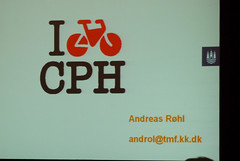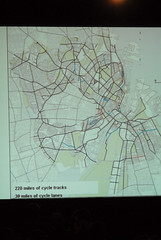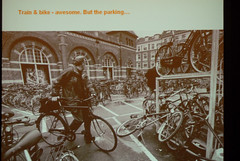
manager for the City of Copenhagen,
Andreas Rohl.
(Photos © J. Maus)
The 2009 National Bike Summit kicked off tonight with a pep rally of sorts, and the head cheerleader was Andreas Rohl, bike program manager for the city of Copenhagen.
For the uninitiated, Copenhagen is the world class cycling city all others aspire to. Don’t believe that claim? 36% of people who enter the city for work or for school do so on a bicycle and among people who live in their city’s core, 55% bike to work.
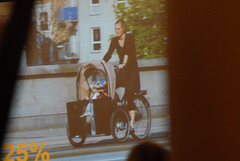
in Copenhagen recently. An “interesting
planning problem” says Rohl.
Before his keynote speech in front of an estimated 4-500 summit attendees, I joined Rohl and about 30 other people at a smaller reception here at the Reagan International Trade Center on Pennsylvania Avenue. When I first approached Rohl, he was busily chatting with none other than his Portland counterpart — city bike coordinator Roger Geller.
Roger and I were both interested to hear what challenges (if any) Mr. Rohl faces in his bike utopia. One of the first things he mentioned was the expansion of their Metro (trains) system. He called it “the greatest threat to the public health of Copenhagen,” because of how it would contribute to less active transportation. (With his accent, I’m not quite sure if he was serious or not, but I think he was.)
On a more serious note, Rohl said that he is working hard to make their bike facilities more “communicative”. He said that his engineers focus too much on function and not enough on making facilities communicate ideas and expected behaviors to riders. Geller just nodded and smiled; he said, our streets are “our largest canvas”.
Somehow, snow came into the conversation so I immediately asked Rohl how they prioritize bikeway sweeping after a major snow storm. He said the city has a set policy broken into three levels: 1) all cycle tracks and 4-5 main roads, 2) all the main roads and 3) everything else. I love that. All cycle tracks first.
Back to Rohl’s keynote. He started off with a series of numbers to help paint the Copenhagen biking picture:
- 36% of commuters use bike to go to work or school (the largest percentage of any mode).
- 750,000 miles are covered by bike in Copenhagen each day.
- 55% of central city residents bike to work.
- 60% of Copenhagen residents say biking when asked what is your main mode of transport?
- 1:1 is the ratio of bikes to people in Copenhagen. 500,000 bikes and 500,000 people.
- 25% of families with 2 or more children have a cargo bike. (dream on Clever Cycles!)
- 30,000 bike trips each day on Copenhagen’s busiest bikeways.
- 100 years ago Copenhagen built their first cycle track.
With stats like that, it’s no surprise that in Copenhagen, “riding a bike is like brushing your teeth”. “Which is great,” Rohl continued, “until we try to communicate with them.” The point he was making is that in Copenhagen (unlike Portland), people don’t identify as “cyclists”. They simply ride their bike. So, when an advocacy group or the city tries to target an education campaign to them, there’s no specific group to aim for. A good problem to have for sure.
On the topic of safety, Rohl had a particularly memorable insight. Of course it’s important, he said, but it’s even more important to not put too much focus on it. “If you tell someone to think of an elephant,” he said, “they’ll think of an elephant.” His point was that if advocates and planners are always talking about safety (which the U.S. is very guilty of) than people — especially the ones advocates are trying to attract — will assume it’s a dangerous activity.
Portland and Copenhagen have vastly different cultures around cycling, but here’s something we have in common:
This slide is very similar to one I’ve published many times. Like Portland, Copenhagen has seen a lower crash rate as more people ride bikes.
And, you’ll have to excuse the poor quality of this next slide photo…
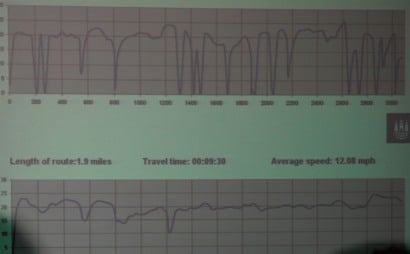
Have you ever heard of Copenhagen’s “green wave”. This is essentially a traffic signal system that is set specifically for bike speed so that, if you ride the prescribed speed, you will hit nothing but green lights. The chart above shows how much smoother bike traffic flow goes on streets where the “green wave” is installed.
And do you recall the first-ever cycle track Portland is planning to build out in the Cully neighborhood? Well, check out this slide for a look at Copenhagen’s cycle track network — over 200 miles strong.
OK, one last slide and then I’m off to a party/reception hosted by the Thunderhead Alliance:
Copenhagen takes the bike-transit connection very seriously. But still, with 500,000 bikes in their city, they can never seem to find enough space to park them all.
At the end of Rohl’s speech, League of American Bicyclists Director Andy Clarke said of Copenhagen; “This is a vision of where we want to get to.”
And the work to get there starts tomorrow morning at 8:00 a.m.
Stay tuned for more coverage of the 2009 National Bike Summit. I’m also posting numerous updates throughout the day on Twitter.


